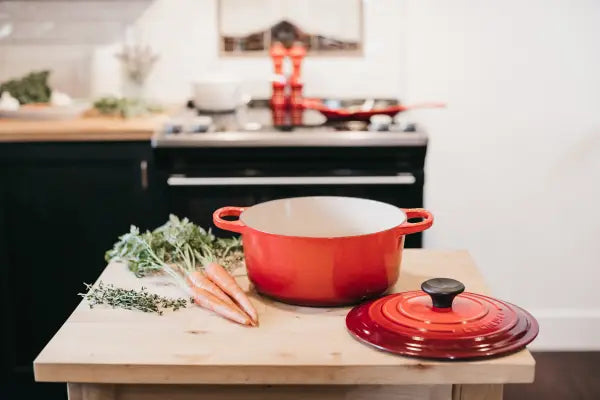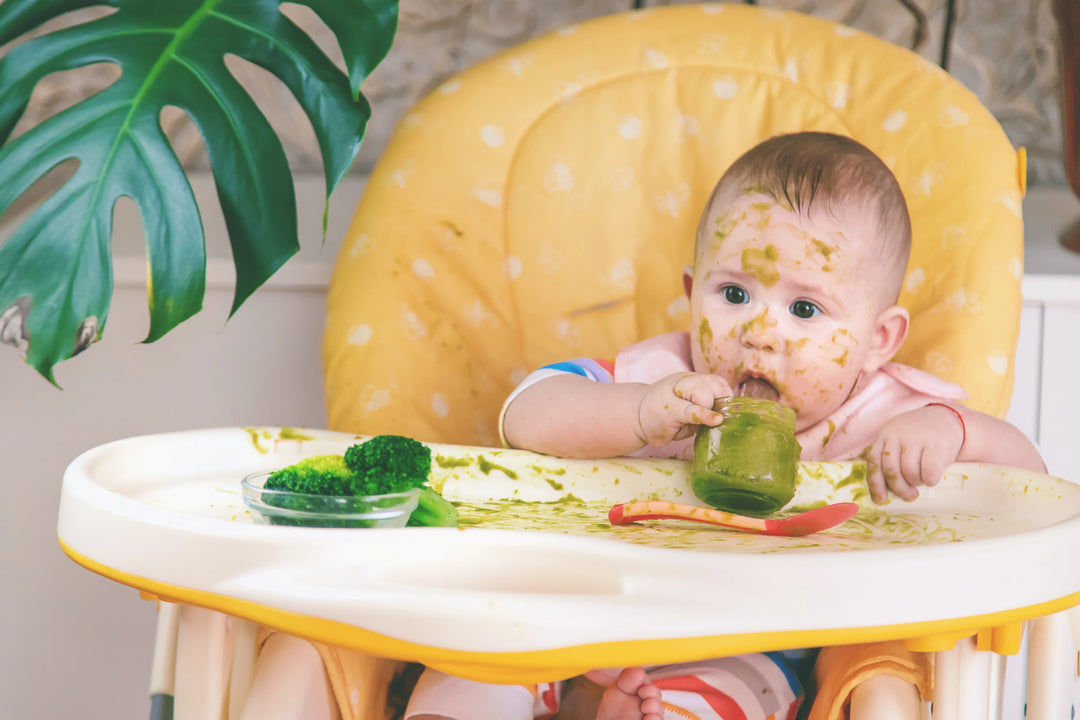How to Start Baby Led Weaning Safely: What to Know About Choking and Gagging

Starting solids is such an exciting milestone, but it can also be filled with anxiety for parents. One of the most common fears I hear from parents is this: "What if my baby chokes?"
Many families are choosing to feed their little ones through a method called baby-led weaning (BLW), where babies self-feed soft whole foods instead of being spoon-fed purees. While this method offers amazing opportunities for independence and sensory development, it's important to understand how to make it safe. With the right preparation and supervision, baby-led weaning can be both fun and safe.
What is baby-led weaning, really? A gentle intro for curious parents
Baby-led weaning is an approach to starting solids where babies feed themselves from the beginning. Instead of purees, parents offer soft, graspable pieces of food that babies explore at their own pace. Think of it as baby-sized avocado slices or well-steamed veggies your little one can pick up and gum. This method supports exploration, sensory learning, and self-regulation.
Why some families choose this approach to starting solids
When done safely, BLW can help support:
-
Oral-motor development
-
Hand-eye coordination
-
A healthy relationship with food
How to tell the difference between gagging and choking when starting solids
This is a big one. I want every parent to know that gagging is normal and expected when babies are learning to eat. It might look and sound dramatic, but it is actually a protective reflex. In fact, babies' gag reflex is located farther forward in the mouth than in adults, which helps prevent true choking.

What gagging might look (and sound) like
-
Loud coughing or retching
-
Red or teary eyes
-
Occasional spitting or vomiting
-
Baby remaining alert and breathing
How choking is different — and when to take action
-
Silence or inability to cry or cough
-
Skin turning blue or gray
-
Baby appearing panicked, wide-eyed, or limp
-
No airflow in or out
If your baby gags, here’s how to respond calmly
If your baby is gagging, try not to intervene. Stay calm and let them work through it. You can model spitting the food out by getting on their level and sticking your own tongue out. It can seem like instinct to stick your finger in their mouths and fish out the food, but please avoid this as it can surprise your infant and may cause the gagging to progress to choking.
How to keep baby-led weaning safer (and less stressful)
The American Academy of Pediatrics supports BLW as a developmentally appropriate option when done safely. Here's how to reduce the risk:
Is your baby ready to start solids? Here's a simple readiness checklist
Before starting baby-led weaning, your baby should be:
-
Around 6 months old
-
Sitting upright with little or no support
-
Showing good head and neck control
-
Reaching for food and interested in mealtimes
Starting too early increases choking risk, especially before babies can sit independently. Do you want more reassurance your baby is ready? Read more about the signs of readiness.

Why seating matters: Safe positions for self-feeding
Always feed your baby in a highchair with good back support and ideally a footrest. Your baby should be sitting at a 90-degree angle, not leaning back or slouching. Avoid feeding in a stroller, car seat, or swing.
How to choose safe first foods for baby led weaning
The food should be soft enough to mash easily between your fingers. Cut it into pieces large enough for baby to hold in their fist with some sticking out, like a handle.
Foods that are easy for babies to hold and explore
-
Ripe banana (sliced lengthwise into quarters)
-
Avocado with some peel left on for grip
-
Steamed or roasted sweet potato wedges
-
Soft-cooked broccoli florets
Foods to avoid at first due to choking risk
-
Raw carrots or apples
-
Whole grapes
-
Chunks of meat or cheese
-
Popcorn
-
Hot dog slices (even cut into coins)
Distractions at the table? Why focused mealtimes help prevent choking during baby led weaning
Avoid watching TV or playing while eating. Eating should be the main activity and your little one needs to focus on safely getting the food into their bellies.
Why babies need constant supervision while learning to eat
This one can’t be overstated. Never leave your baby alone while eating, even for a minute. Choking can happen silently and quickly.
What to do if your baby chokes during a meal (step-by-step support)
Even with precautions, choking can happen. It’s essential for all caregivers to know infant CPR.
What not to do during a choking incident
Don’t put your fingers in your baby’s mouth unless you can clearly see the object and easily remove it. Blind finger sweeps can push the object deeper.
How to help: Back blows, chest thrusts, and staying calm
Here’s the basic response for babies under one year old:
-
Call for help or have someone call 911.
-
Give 5 back blows. Lay the baby face down on your forearm, supporting their head and neck. Use the heel of your hand to give five firm blows between the shoulder blades.
-
Give 5 chest thrusts. Turn the baby face up, keeping their head lower than their chest. Use two fingers to push down quickly on the center of the chest, just below the nipple line.
-
Repeat as needed until the object is dislodged or help arrives.
-
If baby becomes unresponsive, start CPR.
Infant CPR can build your confidence — and save lives
The American Red Cross and American Heart Association offer classes and videos designed for parents:
-
Red Cross Infant CPR Guide
-
American Heart Association CPR Training

What to know about using anti-choking devices like LifeVac or Dechoker
You may have seen videos of anti-choking suction devices like the Dechoker or LifeVac. These are marketed as life-saving tools that pull food out of a choking child’s airway.
Why the AAP doesn’t currently recommend them
-
There’s little independent evidence showing they work reliably
-
Using them could delay proven, effective methods like back blows and chest thrusts
-
They can cause injury if used incorrectly
That said, it’s understandable to want every possible tool at your disposal. While these devices should never replace CPR training or standard first aid, it’s reasonable to keep one in the home as a last resort if you feel more comfortable having it on hand.
High-risk choking foods and how to serve them more safely
Certain foods should be avoided when starting solids because they are common choking hazards, regardless of feeding method.
Skip these for now:
-
Whole grapes (cut into quarters lengthwise if offering)
-
Cherries with pits
-
Raw carrot sticks or chunks (serve cooked or grated)
-
Popcorn
-
Nuts and seeds
-
Spoonfuls of crunchy peanut butter
-
Hot dogs, unless sliced into very thin, lengthwise strips
-
Hard candies, gum, and marshmallows
Most choking incidents in toddlers happen outside of meals, often when children grab food while playing or walking. Try to create the habit of sitting down for every snack or meal, even if it’s brief.

Choking is scary, but baby-led weaning can still be safe and supportive
Choking is a real risk, but it doesn’t mean you have to avoid baby-led weaning altogether. With the right steps such as waiting until your baby is ready, offering soft and safe foods, learning CPR, and staying present during meals, you can introduce solids in a way that is both developmentally supportive and safe.
Where to find expert-approved baby led weaning safety resources
Learn infant CPR
Choking prevention and feeding safety


Written by Dr. Michelle Shiffman, MD
Pediatrician & Advisor at Bébé Foodie
Dr. Michelle Shiffman is a board-certified pediatrician based in Denver, Colorado. She brings her expertise in early development, food introduction, and culturally-sensitive care to Bébé Foodie, where she supports the creation of our evidence-based content and contributes to our expert panel. Michelle’s favorite part of her work is connecting with families during infant and toddler visits—especially when it comes to discussing developmental milestones and feeding. As a mom herself, she's also experienced the ups and downs of starting solids and managing picky eating.



Leave a comment